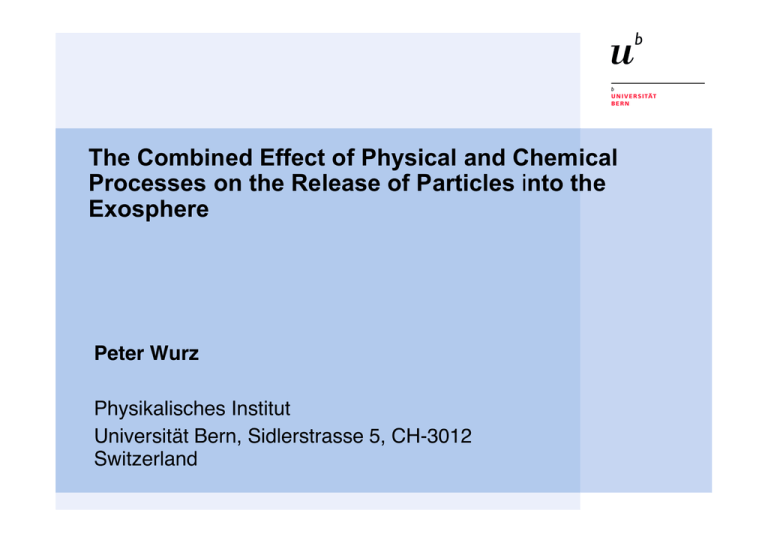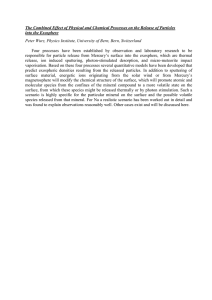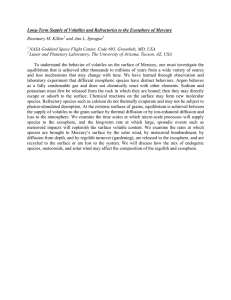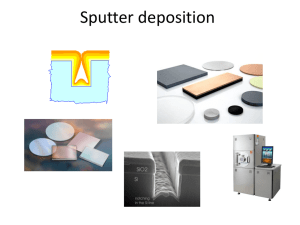The Combined Effect of Physical and Chemical Exosphere Peter Wurz
advertisement

The Combined Effect of Physical and Chemical Processes on the Release of Particles into the Exosphere Peter Wurz Physikalisches Institut Universität Bern, Sidlerstrasse 5, CH-3012 Switzerland Introduction > The gaseous envelope of Mercury is a so-called surface bound exosphere, i.e., it has its origin in the surface of Mercury > Understand the physics of surface release processes — Thermal release, photon stimulated desorption, ion sputtering, micrometeorite impact vaporisation > Understand the external agents causing particle release from the surface — SW and MS ion precipitation, photon field, meteorite fluxes > Understand what is actually released from the surface — Total density of exosphere N0 < of 1012 m–3 from by the Mariner 10 occultation experiment (Fjeldbo et al., 1976; Hunten et al., 1988). — The exospheric species observed to date (H, He, O, Na, K, and Ca) together give a density of exosphere N0 ≈ of 1010 m–3 — Presently – – 3. Dezember 2010 Mostly atoms considered Strong bias toward Na 2 Surface Release Processes > Thermal desorption — Sun-lit surface — Release of volatiles — Low scale heights > Photon-induced desorption — — — — > Sputtering — — — — > Sun-lit surface Important for Na and K Perhaps H2O and S Low scale heights Induced by energetic particle impact Ion precipitation (solar wind, magnetospheric ions) High scale heights, escape Roughly reproduces surface composition Meteorite impact vaporization — Moderate scale heights — Roughly reproduces surface composition 3. Dezember 2010 3 Distribution of Sputtered Particles The sputter yield is described ( ) Y ( E, ! )!=!Ytot Ein , mSW , msurf ,.. " f (E)" f (! ) Simplified energy and angular distribution fE (Ee ) ! 2E B Ee ( Ee + E B ) 3 f (! )!=!cos ! Species and surface information Full energy and angular distribution " 6E B Ee Ee + E B % fE (Ee ) = 1! 3 $ Emax '& 3 ! 8 E B Emax ( Ee + E B ) # Emax = Ein 4mSW msurf (m 3. Dezember 2010 SW + msurf ) 2 $ n' #& ) % 2( n n f (! )!=! cos (! ) " # $ 1+ n' &% ) 2 ( 4 Energy distribution of sputtered particles H escape O escape Ca escape Fe escape Fe Ca O 3. Dezember 2010 H 5 Model mineralogical composition of Mercury’s surface Mineral Chemical composition Mineral abundance (mol %) Iron/nickel metal Fe, Ni 0.07% Troilite Fe S 0.15% Daubreelite Fe Cr2 S4 0.15% Oldhamite Ca S 0.15% Sphalerite (end Zn S 0.58% member) Feldspar group Albite Na Al Si3 O8 17.44% K-feldspar K Al Si3 O8 0.39% Anorthite Ca Al2 Si2 O8 8.72% Ilmenite Fe Ti O3 Apatite Pyroxene group Wollastonite Ferrosilite Enstatite Olivine group Fayalite Fosterite Range (mol %) 0.04 – 0.15 % 0 – 0.5% 0 – 0.3 % 0 – 0.3 % 0 – 1% 13 – 21 % 0.2 – 0.7 % 6.7 – 11 % 0.02 – 0.15 % Ca5 (P O4)3 OH 0.07% 1.45% Ca Si O3 Fe2 Si2 O6 2.91% 0.36% Mg2 Si2 O6 29.06% 2.4 – 3.5 % 0.1 – 0.5 % 24 – 34 % Fe2 Si O4 Mg2 Si O4 2.18% 36.33% 1.7 – 2.7 % 31 – 41 % 3. Dezember 2010 0 – 2% P. Wurz, J.A. Whitby, U. Rohner, J.A. MartinFernandez, H. Lammer, and C. Kolb, Selfconsistent modelling of Mercury’s exosphere by sputtering, micrometeorite impact and photonstimulated desorption, Planet. Space Sci. 58 (2010) 1599-1616. 6 Sputtering of Molecules: Example of CaO 3. Dezember 2010 7 Sputtering of CaO 3. Dezember 2010 A. Schaufelberger, P. Wurz, Planet. Space Sci. (2010) in preparation 8 Sputtering of Clusters from Metals Franzreb et al., Phys. Rev. B 43 (1991) 14396 Gnaser and Hofer, Appl. Phys. A 48 (1989) 271 3. Dezember 2010 P. Wurz, W. Husinsky, G. Betz, Appl. Phys. A 52 (1991), 213-217. 9 Sputtering of Clusters from Metals 3. Dezember 2010 Wahl and Wucher, Nucl. Instr. Meth. B 94 (1994), 36 10 Sputtering of Oxides: Sputtered Ions Benninghoven, Surf. Sci. 53 (1975), 596 3. Dezember 2010 11 Sputtering of Oxides: Secondary Neutrals Oechsner et al., Surf. Sci 76(1978), 343 3. Dezember 2010 12 Chemical Specificity > Secondary cluster ions sputtered from inorganic salts : — specific anionic groups — difficult quantification > Secondary neutral clusters sputtered from inorganic salts : — up to now only diatomics — chemically specific abundance pattern — quantification by statistical clustering analysis — larger clusters ?? 3. Dezember 2010 Benninghoven, Z., Naturforsch. 24A (1969) 859 13 Kinetic Energy Distribution: Oxide and Metal Clusters 5 10 4 10 10 Ag2 102 Ag3 3 flux (a.u.) Ag 1 10 1 -1 10 -2 10 Ag4 Ag5 Ag6 -3 10 -4 10 Ag7 -5 10 -6 10 Wucher & Oechsner, Nucl. Instr. Meth. B 18 (1987), 458 3. Dezember 2010 0.1 1 10 energy (eV) 100 Wahl and Wucher, Nucl. Instr. Meth. B 94 (1994), 36 14 Internal Energy of Sputtered Clusters Experimentally measured internal temperature: Molecule Temperature S2 1500 K 300 K Cs2 K2 Na2 1470 K 1025 K 1000 K Ag2 2700 K (vib) 6700 K (rot) AlO CH 5000 K 13000 K 4500 K 3. Dezember 2010 (vib) (rot) Reference De Jonge et al., NIM B82 (1993) 352 Fayet & Wöste, Phys. Rev. B10 (1985) 6792 (vib) (rot) Wucher, Phys. Rev. B49 (1994) 2012 Varenne et al., NIM B 171 (2000), 259-276. Thomas & de Koning, Chem. Phys. 7 (1975) 303 15 Summary of Sputtering of Molecules > Variability of species and size — Sputtered ions and neutral clusters — Abundance of clusters can outnumber the atomic species — Power law abundance distribution vs. size for metal clusters > Kinetic energy distribution — Narrower than atom distribution — At lower binding energy — Independent of size for large clusters Size dependent photo-ionisation cross section > High internal temperature > — Unimolecular fragmentation — Abundance governed by cluster stability — Time dependent abundance 3. Dezember 2010 16 Chemical Sputtering Alteration of the of sodium-bearing silicates by proton irradiation was considered by the following mechanism (Potter, GRL 1995) : Proton precipitation causes chemical alteration of the surface, freeing the Na atoms from bounds in the crystalline structure on the surface 3. Dezember 2010 S/ W PS Thermal desorption and PSD deplete Na in the surface D 2H + Na2SiO3 → 2Na + SiO2 + H2O TD S /W Surface element Na 17 A. Mura, et al., Icarus 200 (2009) 1–11. Schleicher, et al., Astron. Astrophys. 425, (2004) 1119–1124. SIMULATION OBSERVATIONS Parameter Density (max) Data 2500 cm–3 Model 1000 cm–3 Column dens. (max) 7×1010 cm–2 5×1010 cm–2 Total amount 4×1027 5×1027 (*) Scale height 200 ... 500 km ~1000 km 1.6 km/s 1.4 km/s parallel 3. Dezember 2010 doppler width 18 Chemical Sputtering > A model that combines alteration of the surface by impinging protons and release via PSD — Protons liberate Na atoms from the crystal lattice and subsequently are released via PSD and TD (based on Potter, 1995). — A. Mura, P. Wurz, H. Lichtenegger, H. Schleicher, H. Lammer, D. Delcourt, A. Milillo, S. Orsini, S. Massetti, and M.L. Khodachenko, Icarus 200 (2009) 1–11. > Explains Schleicher et al. 2004 Mercury transit observations — 2D distribution: N/S asymmetry, dawn-dusk asymmetry — Density and scale height — Mean velocity > Explains the MESSENGER Na observations — Extended tails > Neither PSD, nor IS alone are able to explain the observed Na features, but the combined action of them is needed. 3. Dezember 2010 19 Chemical Sputtering Alteration of the of sodium-bearing silicates by proton irradiation was considered by the following mechanism (Potter, GRL 1995) : S /W 2H + Na2SiO3 → 2Na + SiO2 + H2O Production of water exosphere: N0 = 1.5·109 m–3; NC = 1.0·1014 m–2 Total water production: QH20 = 8.4·1024 mol/s = 0.25 kg/s Killen and Ip, 1999: N0 < 1.5·1013 m–3 Exosphere 2H + Na2SiO3 → 2Na + SiO2 + H2O 3. Dezember 2010 Na2SiO3 → SiO2 Surface 20 Model mineralogical composition of Mercury’s surface Mineral Chemical composition Mineral abundance (mol %) Iron/nickel metal Fe, Ni 0.07% Troilite Fe S 0.15% Daubreelite Fe Cr2 S4 0.15% Oldhamite Ca S 0.15% Sphalerite (end Zn S 0.58% member) Feldspar group Albite Na Al Si3 O8 17.44% K-feldspar K Al Si3 O8 0.39% Anorthite Ca Al2 Si2 O8 8.72% Ilmenite Fe Ti O3 Apatite Pyroxene group Wollastonite Ferrosilite Enstatite Olivine group Fayalite Fosterite Range (mol %) 0.04 – 0.15 % 0 – 0.5% 0 – 0.3 % 0 – 0.3 % 0 – 1% 13 – 21 % 0.2 – 0.7 % 6.7 – 11 % 0.02 – 0.15 % Ca5 (P O4)3 OH 0.07% 1.45% Ca Si O3 Fe2 Si2 O6 2.91% 0.36% Mg2 Si2 O6 29.06% 2.4 – 3.5 % 0.1 – 0.5 % 24 – 34 % Fe2 Si O4 Mg2 Si O4 2.18% 36.33% 1.7 – 2.7 % 31 – 41 % 3. Dezember 2010 0 – 2% P. Wurz, J.A. Whitby, U. Rohner, J.A. MartinFernandez, H. Lammer, and C. Kolb, Selfconsistent modelling of Mercury’s exosphere by sputtering, micrometeorite impact and photonstimulated desorption, Planet. Space Sci. 58 (2010) 1599-1616. 21 Water Production on Minerals by SW Irradiation: Experimental Results > Experimental study of irradiation of oxides with ions of solar wind energy — Used deuterium ions to prevent eventual contamination by “laboratory” water — primary neon and deuterium ions remained constant and equal to 3 keV > Studied — 20–30 nm thick oxide films created by oxidation of molybdenum (Мо), copper (Cu), silicon (Si), — lanthanum hexaboride (LaB6), aluminum oxide (Al2O3), — olivine ((MgFe)2SiO4) samples > > > > Investigation of surfaces by secondary ion mass spectrometry (SIMS) Production of water is always observed Efficiency of the synthesis of heavy water 10–2 – 10–3 D2О+/ D+ G.G. Managadze, V.T. Cherepin, V.N. Kolesnik, A.E. Chumikov, Synthesis of H2O at the surfaces of airless space bodies under the action of stellar winds, GRL (2010) 3. Dezember 2010 22 Water Production on Minerals by Proton Irradiation: Experimental Results SIMS Analysis Isotop AMU 18 19 20 + Ne 60 17 90 + + D Ne 234 174 6 321 304 15 362 267 18 3. Dezember 2010 Cu D+ 32 41 56 + 26 26 38 Ne 10 14 28 Si D+ 76 66 48 34 140 112 + Ne 41 22 36 LaB6 D+ 113 72 119 97 194 158 Al2O3 Ne D+ 5 10 5 6 8 2 1 10 9 + Olivine Ne+ D+ 1 11 10 2 36 34 3 36 33 23 LCROSS Impact Data Indicates Water on Moon Schultz et al., Science 330 (2010) 468–472 3. Dezember 2010 24 Micrometeorite Impact Vaporisation > Modelling of impact — — — — At impact: T0 = 10’000 K, P0 = 10’000 bar Calculate T and P during expansion of cloud Calculate chemical evolution during expansion A.A. Berezhnoy and B.A. Klumov, Icarus 195 (2008) 511–522 > At quenching (2500 K and 3 bars), the fractions of Na(atoms)/Na(total) and K(atoms)/K(total) in the fireball are estimated as 0.7 and 0.4, respectively. The corresponding fractions are much lower for more refractory Mg, Ca, and Al because these elements form molecules or condense to form solids (in equilibrium MgO, CaO, and Al2O3, respectively). > Meteoroid impacts lead to the formation of — hot metal atoms (0.2–0.4 eV) produced directly during impacts — very hot metal atoms (1–2 eV, 11’000–22’000K) produced by the subsequent photolysis of oxides and hydroxides in the exosphere of Mercury. 3. Dezember 2010 25 Micrometeorite Impact Vaporisation A.A. Berezhnoy and B.A. Klumov, Impacts as sources of the exosphere on Mercury, Icarus 195 (2008) 511–522 3. Dezember 2010 26 Micrometeorite Impact Vaporisation A.A. Berezhnoy and B.A. Klumov, Impacts as sources of the exosphere on Mercury, Icarus 195 (2008) 511–522 3. Dezember 2010 27 Conclusion: Surface Processes > Ion impact on surfaces — Sputtering — Release of atoms, molecules, ions — Chemical and mineralogical modification of the surface — Production of volatiles > Meteorite impact on surfaces — Release of surface material — Decomposition of surface material (atoms, molecules, ...) — Production of chemical compounds in plasma plume — Aglutinates, ... — Mixing with impactor material 3. Dezember 2010 28




